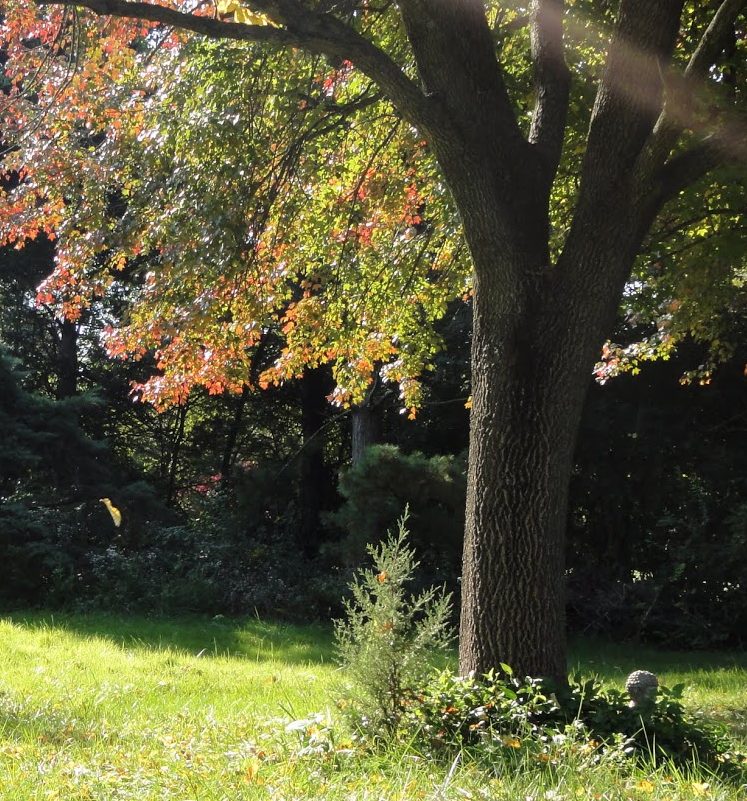Good morning!
Suddenly it became winter, sub- and around freezing temperatures, almost from summer. We, however, have a peaceful, serene world with bright sunlight after our sittings. Here is a haiku poem of momiji, maples or colored leaves:
Showing the back,
Showing the front,
A falling maple leaf.
Life is change with both sides, birth and death, growing and decaying, gain and loss, etc. Both sides are the back and front of one thing, change. All phenomena are in the Dharma of Dependent Co-origination, thus all are related and relative.
Here is another haiku poem of momiji, which shows the apparent both sides of our life and the deeper one truth of it, changelessness – no life or still life, death or eternity, nothingness or substance, nil or nirvana, …:
A falling maple leaf;
An unfalling maple leaf,
Is also a falling maple leaf.
Life is not limited to a maple, but unlimited in its forms, functions, phases, systems, significances, etc. Still life is not necessarily no life, dead life, nothingness, but life, living, nirvana. I made a haiku poem of a fallen maple leaf:
A maple leaf falling,
The moon’s shining,
Bird flocks migrating.
When trees shed their leaves, we can see the vast sky, the moon shining throughout the world, and birds migrating. Birds are said to fly up from water, leaving no dirty water, and away, leaving no footprints. Another poem I made:
Birds migrating,
Leaving no trace
Of spring and fall.
“Traceless awakening goes on and on,” Dogen said, “The sky being vast, penetrating through heaven, a bird looks like a bird.” Humans look like humans, but awakened ones can taste amrita, ambrosia of immortality, beyond changes.
November 2, 2019 C.E. Dharma talk
Note: Here is the poem Dogen made, titled “Poem made on the original face,” which was quoted by Yasunari Kawabata in his Nobel Prize Memorial Lecture speech:
Flowers in spring,
Cuckoos in summer,
The moon in autumn,
Snow in winter,
Clear and cool.
お早うございます!
俄かに氷点下とその近辺の温度で冬になりました、ここでは殆ど夏から急転直下。私達は、しかし、坐禅の後で平和で清澄な、明るい日光の世界に居ます。こんなモミジ、楓或いは紅葉、の俳句があります:
裏を見せ表を見せて散る紅葉
命は生と死、成長と老衰、得と損などの両面をもった変化です。両面は一つのもの、変化、の表裏です。一切現象は因縁生起の法にありますから、一切は相依し相対しています。
別のモミジの俳句がありますが、それは私達の表面的な両面とその更に深い一つの真理、即ち不変-無生命か生物か、死滅か永遠か、空無か存在か、虚無か涅槃か、を示しています:
散る紅葉散らぬ紅葉も散る紅葉
命はモミジに限らず、その形態、機能、様相、組織、意味等は無限です。静物は必ずしも無生命、死生命、空無ではなく、生命、生活、涅槃でもあります。散ったモミジの俳句を作ってみました:
紅葉散り月輝きて鳥渡る
樹々が葉を落とすと広大な空や、世界に輝きわたる月や、鳥が渡るのを見ることが出来ます。「飛ぶ鳥跡をのこさず」と言われ水から飛び上がる時には水を濁らす事なく、飛び去ってその跡を残しません。もう一句作りました:
鳥渡り春夏秋冬跡も無し
「慫跡なき悟りを長長出せしむる」と道元は言い「空闊透天なり、鳥飛ぶも、鳥の如し」と言っています。人間は人間の如しですが、覚者は変化を超えた甘露、不死の神饌、を味わうことが出来ます。
2019共通年11月2日 法話
註:川端康成がノーベル賞受賞記念講演で引用した道元の「詠本来面目」と題された和歌は次のようなものです:
春は花夏ほととぎす秋は月
冬雪冴えて涼しかりけり
The last photo is from tenki.jp
最後の写真はtenki.jpよりの転載




